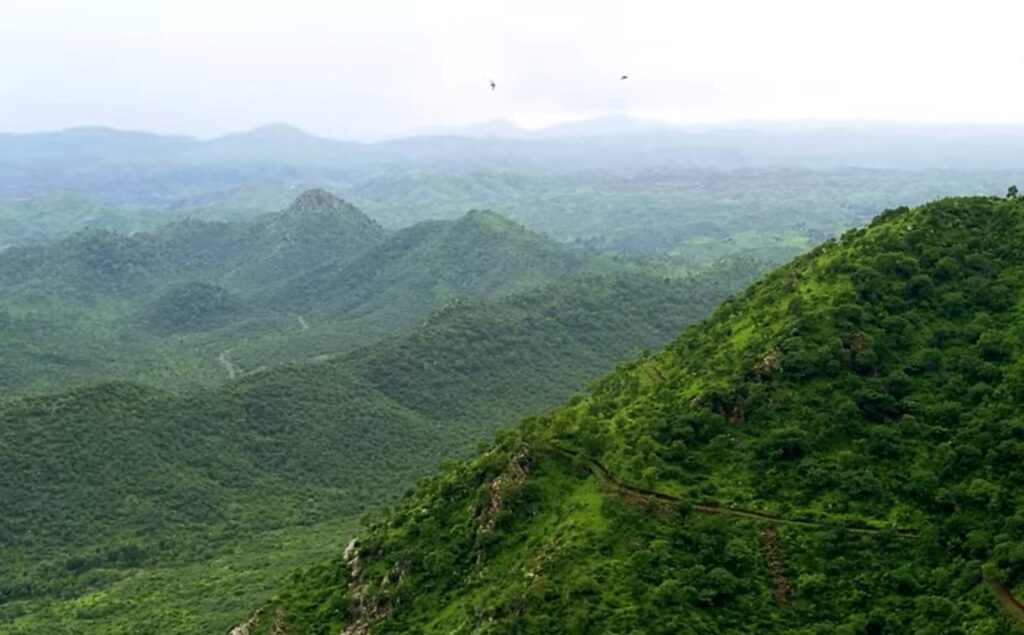The Aravalli Range, also known as Aravallis, is a mountain range in Western India, stretching from Gujarat through Rajasthan to Haryana. The range is one of the oldest mountain systems in the world and has an ancient geological history dating back millions of years.
The Mountain Range is a significant ecological zone and is home to a variety of flora and fauna. The range is known for its rich biodiversity and is home to several wildlife sanctuaries and national parks. The Sariska Tiger Reserve, Ranthambore National Park, and Keoladeo National Park are some of the most popular wildlife sanctuaries in the Aravalli Range.
Location of Aravalli Range
The Range is located in western India, spanning across the states of Gujarat, Rajasthan, Haryana, and Delhi. It extends approximately 800 kilometers (500 miles) from the northeastern end of Gujarat to the southwestern tip of Haryana. The range passes through various cities and regions, including Udaipur, Mount Abu, Ajmer, Alwar, and Faridabad.
The Aravalli Range has played a significant role in the history and culture of India. The range has been a source of minerals, including copper, lead, zinc, and silver, which have been mined for thousands of years. The range has also been a source of marble, which has been used in the construction of several famous landmarks, including the Taj Mahal.
Features and Significance of Aravalli Mountain Range
The Aravalli Range in India is known for its distinct features and significant ecological and historical significance. Here are some key features and aspects of the mountain Range:
Geological Importance: The Aravalli Range is one of the oldest mountain ranges in the world, dating back around 350 million years. It consists of ancient rocks and has undergone complex geological processes over millions of years.
Biodiversity: The Aravalli Range supports a diverse range of flora and fauna. It is home to various species of plants, mammals, birds, reptiles, and insects. The range provides important habitats for wildlife, including leopards, nilgai, chinkara, and many bird species.
Cultural and Historical Significance: The Aravalli Range has historical and cultural importance in the region. It is associated with several ancient civilizations, including the Indus Valley Civilization, and has historical sites, forts, temples, and stepwells that showcase the rich heritage of the area.
Watershed Function: The Aravalli Range serves as a significant watershed, supplying water to numerous rivers, lakes, and groundwater systems. It helps in regulating the flow of water and plays a vital role in sustaining the water resources of the region.
Recreational and Tourism Value: The scenic beauty and natural landscapes of the Aravalli Range attract tourists and nature enthusiasts. The range offers opportunities for activities like hiking, trekking, wildlife spotting, and exploring historical sites.
Ecological Services: The Aravalli Range provides various ecological services, including soil conservation, carbon sequestration, and maintaining the microclimate of the surrounding areas. The forests in the range contribute to the overall well-being of the environment.
Mineral Resources: The Aravalli Range has significant mineral deposits, including minerals like limestone, marble, quartzite, and granite. These resources have been exploited for various purposes, including construction and industrial use.
Overall, it holds immense ecological, historical, and cultural value. Conservation efforts are essential to protect and restore its ecosystems and ensure the sustainable management of its resources.
Oldest Mountain Ranges
The Aravalli Range is considered one of the oldest mountain ranges in the world. It is estimated to be around 350 million years old, making it one of the ancient mountain systems on Earth. The Aravalli Range has undergone significant geological changes over millions of years, including erosion and weathering, resulting in its current form. It has rich mineral resources and is known for its diverse flora and fauna.
The Aravalli Range is also home to several ancient historical sites, including the famous Dilwara Temples in Mount Abu. The range has been inhabited by various civilizations throughout history, including the Mauryans, Guptas, and Rajputs. The forts of Chittorgarh, Kumbhalgarh, and Amer are just some of the many historical sites that can be found in the Aravalli Range.
Dark Secrets of Aravalli Ranges
The Aravalli Range has unfortunately been associated with illegal mining activities and the presence of mining mafias in the past. Illegal mining involves the unauthorized extraction of minerals from the region without following proper regulations and environmental guidelines. Such activities can lead to deforestation, habitat destruction, soil erosion, and pollution of water bodies.
In the case of the Aravalli Range, illegal mining has been a concern due to the presence of valuable minerals like limestone, marble, and quartzite. Mining mafias have exploited these resources illegally for personal gain, often with little regard for the environmental impact or the well-being of local communities.
Efforts have been made by the government and environmental organizations to curb illegal mining in the mountain Range. Strict regulations have been imposed, and enforcement agencies have conducted raids and taken legal action against those involved in such activities. Conservation initiatives have also been undertaken to restore the ecological balance and protect the natural resources of the region.
It’s important to note that while illegal mining has been a problem, it does not define the entire Range. The region also holds significant cultural, historical, and ecological value, and efforts are being made to preserve and restore its natural heritage.
Aravalli range “The Dying Mountain Range”
The Aravalli Range has been referred to as “the dying mountain range” due to various environmental challenges it faces. The term highlights the degradation and threats that the range has experienced over the years.
One of the significant challenges is deforestation and habitat loss. Rampant urbanization, agricultural expansion, and illegal mining have resulted in the clearing of forests and destruction of wildlife habitats in the Aravalli Range. This loss of vegetation has disrupted ecosystems and impacted biodiversity.
Another issue is the depletion of water resources. The Aravalli Range acts as a crucial watershed, providing water to numerous rivers, lakes, and groundwater systems. However, due to excessive extraction of groundwater for agriculture, industry, and urban needs, the water table has dropped significantly, leading to water scarcity and drying up of water bodies in certain areas.
Additionally, pollution and encroachment have posed threats to the Aravalli Range. Industrial pollution, waste dumping, and untreated sewage have contaminated the soil and water, affecting the overall health of the ecosystem. Unplanned construction and encroachment have further encroached upon the natural spaces, leading to the loss of wildlife corridors and fragmentation of habitats.
Efforts are underway to address these issues and conserve the Aravalli Range. Conservation organizations, government bodies, and local communities are working together to promote afforestation, sustainable land use practices, and the protection of wildlife habitats. Awareness campaigns, stricter regulations, and restoration initiatives aim to revive the ecological health of the region and ensure the survival of the Aravalli Range.
However, the Aravalli Range is not without its challenges. The range is facing threats from mining, deforestation, and other human activities that are causing severe ecological damage. The degradation of the Aravalli Range is a matter of great concern and needs to be addressed urgently.
However, the Aravalli Range is not without its challenges. The range is facing threats from mining, deforestation, and other human activities that are causing severe ecological damage. The degradation of the Aravalli Range is a matter of great concern and needs to be addressed urgently.


